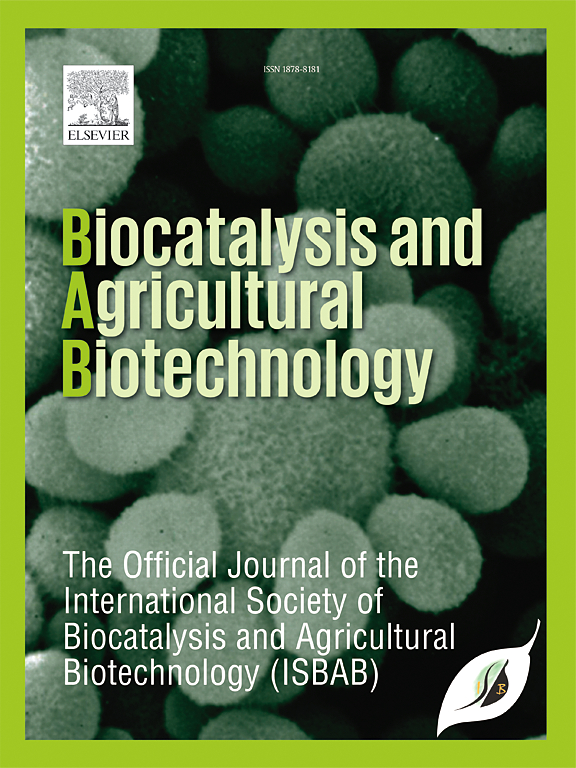对MIPS1 mRNA的干扰导致生物强化lablab (lablab purpureus L.)细胞系植酸水平降低
IF 3.8
Q2 BIOTECHNOLOGY & APPLIED MICROBIOLOGY
引用次数: 0
摘要
抗营养因子植酸在牲畜和人类体内形成难以消化的复合矿物质和带电蛋白质,从而导致矿物质生物利用度降低,是一种主要的饮食限制因素。肌醇1-磷酸合成酶(MIPS)基因编码l -肌醇1-磷酸合成酶,该合成酶将d -葡萄糖-6-磷酸异构化为d -肌醇3-磷酸,这是植酸盐(肌醇六磷酸,InsP6)的前体。可收获期的Lablab豆荚含有高水平的植酸。本工作描述了通过RNA干扰MIPS1基因来发展低植酸含量的实验室品系。用特异性引物PCR扩增MIPS1基因靶区的正义和反义片段,并用T4 DNA聚合酶和dATP处理。pRNAi-LIC载体经Sma - 1酶切,T4 DNA聚合酶和dTTP处理。将正义和反义片段插入载体,在大肠杆菌中克隆,并通过PCR和从阳性菌落分离的质粒限制性酶切证实克隆。通过测序,确定了靶基因片段在载体中的表达方向。将重组质粒转化为农杆菌,通过植物转化获得6个顺基因系。利用茎环反转录PCR证实了目标siRNA的合成。在RNAi细胞系中,MIPS1的比较表达水平下调至0.03 - 0.75倍。成熟荚果中植酸含量由野生型的410.88 mg/100 g显著降低至56.47 ~ 278.53 mg/100 g(降低32.22 ~ 86.25%)。RNAi系的萌发、发育和农艺性能与野生型相当。本文章由计算机程序翻译,如有差异,请以英文原文为准。
Interference for MIPS1 mRNA results in biofortified lablab (Lablab purpureus L.) lines having reduced phytic acid levels
Anti-nutritional factor phytic acid, which causes reduced mineral bioavailability by forming indigestible complexed minerals and charged proteins in livestocks and humans, is a major dietary constraint. Gene Myo-inositol 1-phosphate synthase (MIPS) codes for the enzyme L-myo-inositol 1-phosphate synthase, which isomerizes D-glucose-6-phosphate to D-inositol 3-phosphate, the precursor for phytate (myo-inositol hexakisphosphate, InsP6). Lablab pods at the harvestable stage contain a high level of phytic acid. This work describes the development of lablab lines with low phytic acid content through RNA interference of MIPS1 gene. Sense- and antisense fragments of the target region in the MIPS1 gene were PCR amplified using specific primers and treated with T4 DNA polymerase and dATP. The pRNAi-LIC vector was digested with Sma 1, and treated with T4 DNA polymerase and dTTP. The sense- and anti-sense fragments were inserted to vector, cloned in E. coli and cloning was confirmed through PCR and restriction digestion of plasmids isolated from positive colonies. Through sequencing, the direction of target gene fragments in the vector was confirmed. The recombinant plasmid was transformed into Agrobacterium tumefaciens, and through in planta transformation, six cisgenic lines were obtained. Synthesis of target siRNA was confirmed using stem-loop Reverse Transcription PCR. Comparative expression levels of MIPS1 in RNAi lines were downregulated to 0.03–0.75-fold. The phytic acid level in mature pods was reduced significantly from 410.88 mg/100 g in wild type to 56.47–278.53 mg/100 g (32.22–86.25 % reduction). Germination, development and agronomic performance of the RNAi lines were comparable with those of wild type.
求助全文
通过发布文献求助,成功后即可免费获取论文全文。
去求助
来源期刊

Biocatalysis and agricultural biotechnology
Agricultural and Biological Sciences-Agronomy and Crop Science
CiteScore
7.70
自引率
2.50%
发文量
308
审稿时长
48 days
期刊介绍:
Biocatalysis and Agricultural Biotechnology is the official journal of the International Society of Biocatalysis and Agricultural Biotechnology (ISBAB). The journal publishes high quality articles especially in the science and technology of biocatalysis, bioprocesses, agricultural biotechnology, biomedical biotechnology, and, if appropriate, from other related areas of biotechnology. The journal will publish peer-reviewed basic and applied research papers, authoritative reviews, and feature articles. The scope of the journal encompasses the research, industrial, and commercial aspects of biotechnology, including the areas of: biocatalysis; bioprocesses; food and agriculture; genetic engineering; molecular biology; healthcare and pharmaceuticals; biofuels; genomics; nanotechnology; environment and biodiversity; and bioremediation.
 求助内容:
求助内容: 应助结果提醒方式:
应助结果提醒方式:


